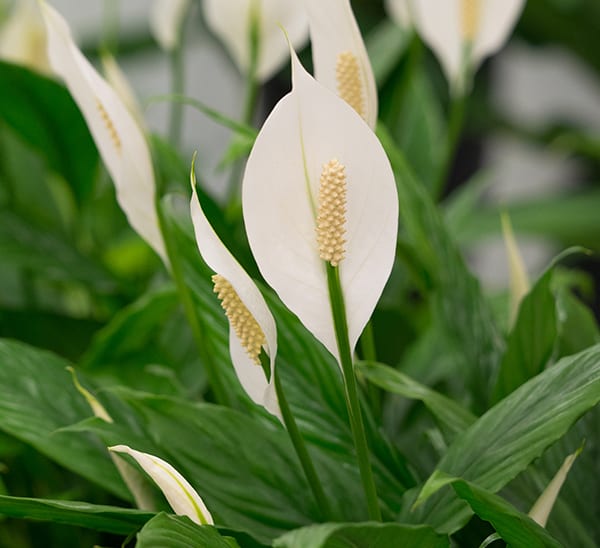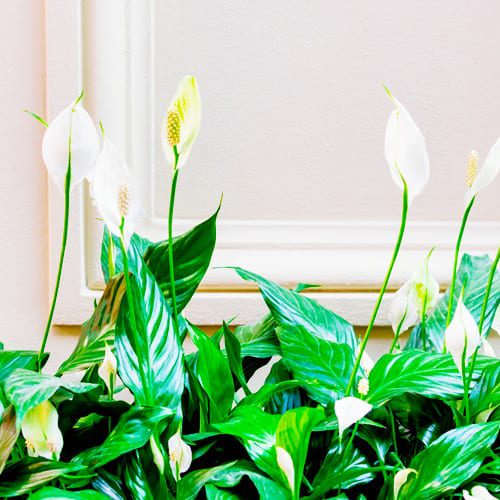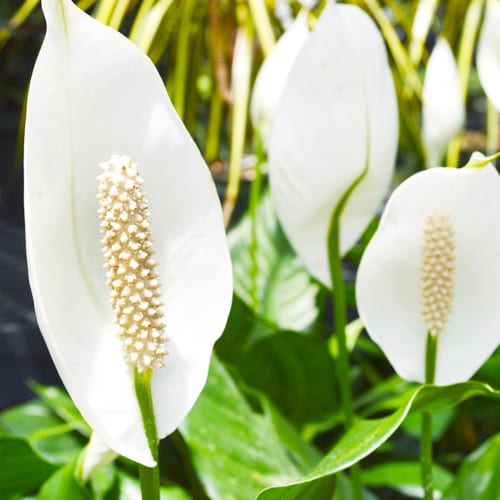Peace Lily
Bring peace and beauty to your home with the easy-to-care-for Spathiphyllum, also known as a Peace Lily. They are tropical, evergreen plants in the Arum family, native to tropical Central and South America. This elegant plant features glossy, deep green leaves and produces stunning white flowers that resemble calla lilies. Not only is the Peace Lily aesthetically pleasing, but it’s also known for its air-purifying properties, helping to improve the quality of the air you breathe. Thriving in low light and requiring minimal watering, the Peace Lily is perfect for busy plant owners or those new to the world of houseplants. Add a touch of tranquility to your space with this timeless and low-maintenance beauty.
Please contact your local store for product availability.
Find a garden center near you.
How to Care for a Peace Lily
Light: Peace lilies thrive in bright, indirect light. Avoid direct sunlight, as it can scorch the leaves. Bright indirect light in a North facing window is my ideal lighting situation. Keep them out of areas where they’ll get direct sunlight all day (such as in a south-facing window), as it may dry them out too much. They can tolerate lower light conditions but may not flower as profusely. Not sure if your space will provide enough light? Consider measuring light to ensure your Peace Lily will receive enough!
Water: Peace lilies are tropical plants and prefer consistently moist soil, but they don’t like to sit in water. Make sure the pot has good drainage. Allow the top inch of soil to dry out before watering. Deeply water the plant until excess water drains from the pot. You can utilize a moisture meter to help you properly gauage soil moisture and avoid overwatering!
Humidity: Peace Lilies are native to the tropical regions of the Americas and appreciate high humidity. Mist the plant regularly or place it on a pebble tray filled with water.
Temperature: Maintain a warm, consistent temperature between 65-80°F (18-27°C). Avoid cold drafts and sudden temperature changes.
Fertilizer: Feed with a balanced liquid fertilizer during the growing season (spring and summer). Dilute the fertilizer to half-strength and apply it once a month.
Repotting: Repot every two to three years to provide fresh soil and more room for growth. Choose a pot that is only slightly larger than the current one.
Pests and Diseases: Peace Lilies are generally resistant to pests and diseases. However, watch for common houseplant pests like mealybugs and spider mites. Treat infestations promptly with insecticidal soap or neem oil.
Toxicity: Peace lilies are mildly toxic. All parts of the peace lily plant contain calcium oxalate, which may cause stomach and respiratory irritation if ingested in large amounts. Keep out of reach of small children and pets who might chew on the plant.
Species: spp.
Other Species Names: Peace Lily
Plant Height: 18-36 in.
Spread: 12-36 in.
Evergreen: Yes
Plant Form: Upright
Summer Foliage Color: Green
Minimum Sunlight: Indirect
Maximum Sunlight: Indirect
The Peace Lily's charm lies in its elegant simplicity. Lush, deep green leaves rise from the base, framing its iconic white, spathe-like flowers. These flowers are modified leaves, surrounding tiny true flowers. Peace Lilies typically reach 1-2 feet tall, making them ideal for various indoor spaces. While some enjoy success growing them outdoors in warm climates, their adaptability to low light and moderate watering makes them perfectly suited for brightening any indoor environment.
Peace Lily flowers feature pointed white blooms that rise above spiking green leaves. This upright growth habit allows it to reach up to 3 feet tall, but it can be happily maintained in containers to suit your preference. Thriving in indirect light, it adds a touch of elegance and a pop of color to any indoor space. While not suited for outdoor landscapes in most climates, the Peace Lily brings its air-purifying properties and tranquil beauty indoors, with its lush, deep green leaves gracefully framing its iconic white flowers.


